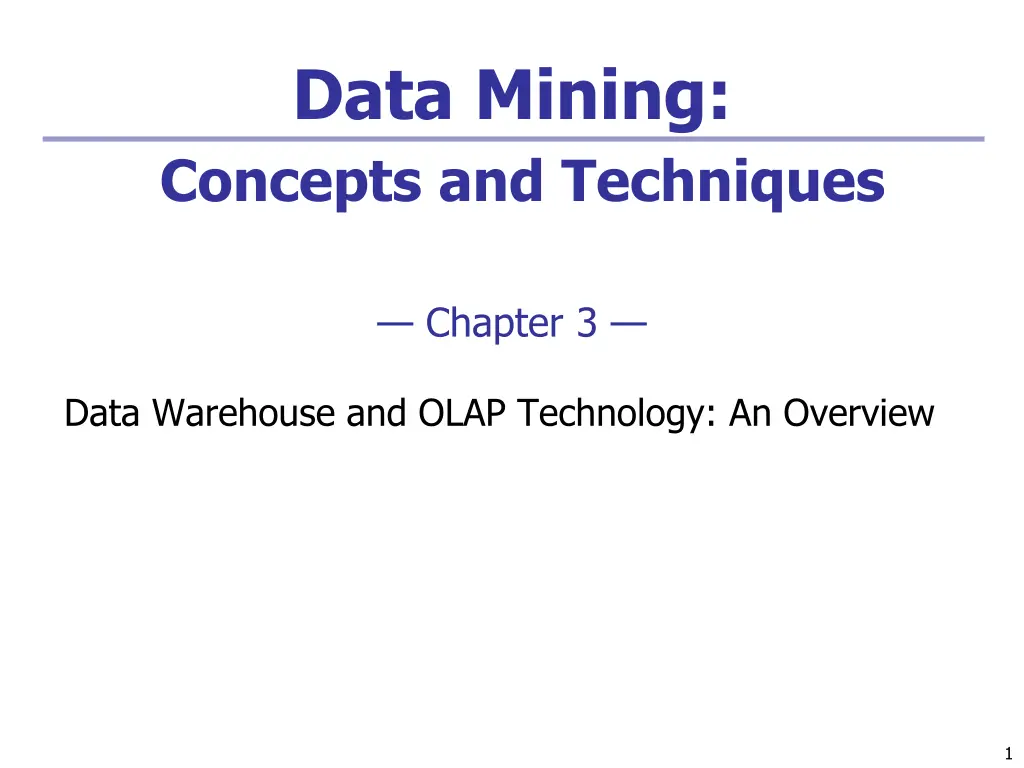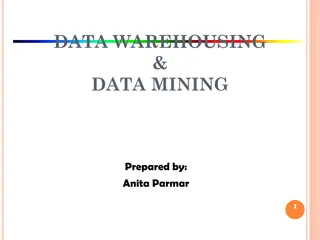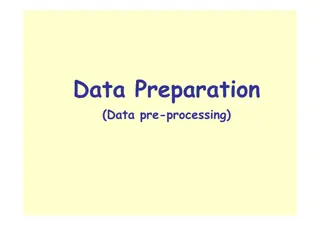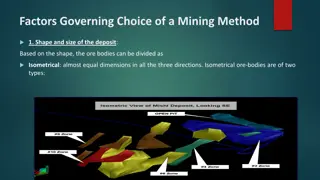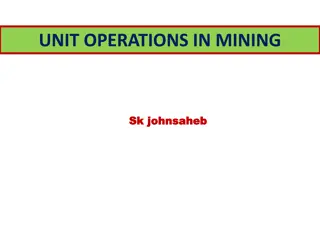Data Mining: Concepts and Techniques
Explore the fundamentals of data warehousing, including architecture, subject-oriented and integrated models, time variance, and nonvolatility. Understand how data warehouses support decision-making processes effectively.
Download Presentation

Please find below an Image/Link to download the presentation.
The content on the website is provided AS IS for your information and personal use only. It may not be sold, licensed, or shared on other websites without obtaining consent from the author.If you encounter any issues during the download, it is possible that the publisher has removed the file from their server.
You are allowed to download the files provided on this website for personal or commercial use, subject to the condition that they are used lawfully. All files are the property of their respective owners.
The content on the website is provided AS IS for your information and personal use only. It may not be sold, licensed, or shared on other websites without obtaining consent from the author.
E N D
Presentation Transcript
Data Mining: Concepts and Techniques Chapter 3 Data Warehouse and OLAP Technology: An Overview 1
Chapter 3: Data Warehousing and OLAP Technology: An Overview What is a data warehouse? A multi-dimensional data model Data warehouse architecture From data warehousing to data mining 2
What is Data Warehouse? Defined in many different ways, but not rigorously (carefully). A decision support database that is maintained separately from the organization s operational database Support information processing by providing a solid platform of consolidated, historical data for analysis. Definition: A data warehouse is a subject-oriented, integrated, time-variant, and nonvolatile collection of data in support of management s decision-making process. W. H. Inmon Data warehousing: Is the process of constructing and using data warehouses 3
Data WarehouseSubject-Oriented Organized around major subjects, such as customer, product, sales. Focusing on the modeling and analysis of data for decision makers, not on daily operations or transaction processing. Provide a simple and concise view around particular subject issues by excluding data that are not useful in the decision support process. 4
Data WarehouseIntegrated Constructed by integrating multiple, heterogeneous data sources relational databases, flat files, on-line transaction records Data cleaning and data integration techniques are applied. To ensure consistency encoding structures, attribute measures, etc. among different data sources E.g., Hotel price: currency, tax, breakfast covered, etc. When data is moved converted. in naming conventions, to the warehouse, it is 5
Data WarehouseTime Variant The time horizon for the data warehouse is significantly longer than that of operational systems Operational database: current value data Data warehouse data: provide information from a historical perspective (e.g., past 5-10 years) Every key structure in the data warehouse Contains an element of time, explicitly or implicitly But the key of operational data may or may not contain time element 6
Data WarehouseNonvolatile A physically separate store of data transformed from the operational environment Operational update of data does not occur in the data warehouse environment Does not require transaction processing, recovery, and concurrency control mechanisms Requires only two operations in data accessing: initial loading of data and access of data 7
Construction of data warehouse requires data cleaning, integration and consolidation. Organization use this information to decision making. Ex. Increasing customer buying patterns), comparing performance of sales by years or by geographic regions, etc. focus(analyzing 8
Data Warehouse vs. Operational DBMS OLTP (on-line transaction processing) Major task of traditional relational DBMS Day-to-day operations: purchasing, inventory, banking, manufacturing, payroll, registration, accounting, etc. OLAP (on-line analytical processing) Major task of data warehouse system Data analysis and decision making Distinct features (OLTP vs. OLAP): User and system orientation: customer vs. market Data contents: current, detailed vs. historical, consolidated Database design: ER + application vs. star + subject View: current, local vs. evolutionary, integrated Access patterns: update vs. read-only but complex queries 9
Chapter 3: Data Warehousing and OLAP Technology: An Overview What is a data warehouse? A multi-dimensional data model Data warehouse architecture From data warehousing to data mining 12
From Tables and Spreadsheets to Data Cubes A data warehouse is based on a multidimensional data model which views data in the form of a data cube. Data cube allows data to be modeled and viewed in multiple dimensions. It is defined by dimensions and facts. Dimensions: are the perspectives or entities with respect to which an organization wants to keep records. For example: AllElectronics may create a sales data warehouse in order to keep records of the store s sales with respect to the dimension time , item , branch , and location . Each dimension may have a table associated with it called dimension table, which further describes the dimension. For ex dimension table for item may contain the attributes item_name, brand and type. 13
Data Cubes A multidimensional data model is typically organized around a central theme, for ex. Sales. This theme is represented by a fact table. Facts are numerical measures. A quantities by which we want to analyze relationships between dimensions. For ex. Facts for a sales data warehouse include dollars_sold(sales amount in dollars), unit_sold(no of unit sold) Fact table contains the names of the facts, or measures as well as keys to each of the related dimension tables. 14
Data Cubes 2-D data cube: a table or spreadsheet for sales data from Allelectronics. Sales data for items sold per quarter in city of vancouver. 2-D representation, the sales for Vancouver, with respect to the time dimension and item dimension(type of item sold) 15
Data Cubes 3-D data cube : view the data according to time and item, as well as location for the cities chicago , new york , toronto and vancourer . 16
Data Cubes 4-D data cube: view data according to time, item type, location as well as supplier. 4-D cube can be represented as the series of 3-D cube. 18
Cube: A Lattice of Cuboids all 0-D(apex) cuboid time item location supplier 1-D cuboids time,location item,location location,supplier 2-D cuboids time,item time,supplier item,supplier time,location,supplier 3-D cuboids time,item,location item,location,supplier time,item,supplier 4-D(base) cuboid time, item, location, supplier 19
Data Cubes Data cube are often referred to as a cuboid. For set of dimensions, we can generate a cuboid for each of the possible subsets of the given dimensions. Result would form a lattice of cuboids. The lattice of cuboids is then referred to as a data cube. The lowest level of summarization is called the base cuboid. The highest level of summarization is called the apex cuboid. The apex cuboid is typically denoted by all. 20
Schemas for multidimensional Databases Star Schema: The most common paradigm. Data warehouse contains:- 1) A large central table (fact table) containing the bulk of the data, with no redundancy, 2) A set of smaller attendant tables(dimension tables), one for each dimension. 21
Example of Star Schema time item time_key day day_of_the_week month quarter year item_key item_name brand type supplier_type Sales Fact Table time_key item_key branch_key location branch location_key location_key street city state_or_province country branch_key branch_name branch_type units_sold dollars_sold avg_sales Measures 22
Schemas for multidimensional Databases Snowflake Schema: Variant of the star schema model. Some dimension tables are normalized, thereby further splitting the data into additional tables. Resulting schema graph forms a shape similar to a snowflake. Snowflake structure can reduce the effectiveness of browsing, since more joins will be needed to execute a query. So, the system performance may be effected. 23
Example of Snowflake Schema time item time_key day day_of_the_week month quarter year item_key item_name brand type supplier_key supplier Sales Fact Table supplier_key supplier_type time_key item_key branch_key location branch location_key location_key street city_key branch_key branch_name branch_type units_sold city dollars_sold city_key city state_or_province country avg_sales Measures 24
Schemas for multidimensional Databases Fact constellation: Sophisticated applications may require multiple fact tables to share dimension tables. Schema can be viewed as a collection of stars, hence is called a galaxy schema or a fact constellation. 25
Example of Fact Constellation time item Shipping Fact Table time_key day day_of_the_week month quarter year item_key item_name brand type supplier_type time_key Sales Fact Table item_key time_key shipper_key item_key from_location branch_key to_location branch location_key location branch_key branch_name branch_type dollars_cost location_key street city province_or_state country units_sold units_shipped dollars_sold avg_sales shipper Measures shipper_key shipper_name location_key shipper_type 26
Data mart A data warehouse collects information abut subjects that span the entire organization, such as customers, items, sales, assets, and personnel, and thus its scope is enterprise-wide. so for data warehouses, the fact constellation schema is commonly used. A data mart, on the other hand is a department subset of the data warehouse that focuses on selected subjects, and thus its scope is department-wide. For data mart star or snowflake schema is used. 27
Defining Star, Snowflake, Fact constellation schemas A Data mining query language can be used to specify data mining tasks. Data warehouses and data marts can be defined using two language primitives : Cube definition. define cube <cube_name> [<dimension_list>]: <measure_list> Dimension definition. define dimension <dimension_name> as <attribute_or_dimension_list>) 28
Cube Definition Syntax (BNF) in DMQL Cube Definition (Fact Table) define cube <cube_name> [<dimension_list>]: <measure_list> Dimension Definition (Dimension Table) define dimension <dimension_name> as (<attribute_or_subdimension_list>) Special Case (Shared Dimension Tables) First time as cube definition define dimension <dimension_name> as <dimension_name_first_time> in cube <cube_name_first_time> 29
Defining Star Schema in DMQL define cube sales_star [time, item, branch, location]: dollars_sold = sum(sales_in_dollars), avg_sales = avg(sales_in_dollars), units_sold = count(*) define dimension time as (time_key, day, day_of_week, month, quarter, year) define dimension item as (item_key, item_name, brand, type, supplier_type) define dimension branch as (branch_key, branch_name, branch_type) define dimension location as (location_key, street, city, province_or_state, country) 30
Defining Snowflake Schema in DMQL define cube sales_snowflake [time, item, branch, location]: dollars_sold = sum(sales_in_dollars), avg_sales = avg(sales_in_dollars), units_sold = count(*) define dimension time as (time_key, day, day_of_week, month, quarter, year) define dimension item as (item_key, item_name, brand, type, supplier(supplier_key, supplier_type)) define dimension branch as (branch_key, branch_name, branch_type) define dimension location as (location_key, street, city(city_key, province_or_state, country)) 31
Defining Fact Constellation in DMQL define cube sales [time, item, branch, location]: dollars_sold = sum(sales_in_dollars), avg_sales = avg(sales_in_dollars), units_sold = count(*) define dimension time as (time_key, day, day_of_week, month, quarter, year) define dimension item as (item_key, item_name, brand, type, supplier_type) define dimension branch as (branch_key, branch_name, branch_type) define dimension location as (location_key, street, city, province_or_state, country) define cube shipping [time, item, shipper, from_location, to_location]: dollar_cost = sum(cost_in_dollars), unit_shipped = count(*) define dimension time as time in cube sales define dimension item as item in cube sales define dimension shipper as (shipper_key, shipper_name, location as location in cube sales, shipper_type) define dimension from_location as location in cube sales define dimension to_location as location in cube sales 32
Measures of Data Cube: Three Categories Distributive: An aggregate function is distributive if it can be computed in a distributed manner. Data are partitioned into n sets. We apply the function to each partition, resulting in n aggregate values. If the result derived by applying the function to the n aggregate values is the same as that derived by applying the function to the entire data set, the function can be computed in a distributed manner. For ex count(), sum(), min(), max(). Distributive measures can be computed efficiently because they can be computed in a distributive manner. 33
Measures of Data Cube: Three Categories Algebraic: An aggregate function is algebraic if it can be computed by an algebraic function with M arguments, each of which is obtained by applying a distributive aggregate function. For ex. Avg() = deviation. A measure is algebraic if it is obtained by applying an algebraic aggregate function. sum()/count(), standard 34
Measures of Data Cube: Three Categories Holistic: An aggregate function is holistic if there does not exist an algebraic function with M arguments that characterizes the computation. For ex. Median(), mode(), and rank(). A measure is holistic if it is obtained by applying a holistic aggregate function. 35
Concept Hierarchies A concept hierarchy defines a sequence of mappings from a set of low-level concepts to higher-level more general concepts. 36
Concept hierarchies Many concept hierarchies are implicit within the database schema. for ex. Dimension location is described by the attributes number, street, city, state, zipcode, and country. Many dimension may be organized in a prtial order, forming a lattice for ex. Partial order the time dimension is month< quarter; week} < year day < { 37
Concept Hierarchies Concept hierarchies defined by discrediting or grouping values for attributes, known as set-grouping hierarchy. a given dimension or 39
A Sample Data Cube Total annual sales of TV in U.S.A. Date 3Qtr 2Qtr 1Qtr sum 4Qtr TV U.S.A PC VCR Country sum Canada Mexico sum All, All, All 40
OLAP Operation Roll up: The roll-up operation performs aggregation on a data cube, either by climbing up a concept hierarchy for a dimension or by dimension reduction. When roll-up is performed by dimension reduction, one or more dimensions are removed from the given cube. 41
Drill-down: Reverse of roll-up. It navigates from less detailed data to more detailed data. Drill-down can be realized by either stepping down a concept hierarchy for a dimension or introducing additional dimensions. Slice: performs a selection on one dimension of the given cube, resulting in sub cube. Dice: defines a sub cube by performing a selection on two or more dimensions. 42
Chapter 3: Data Warehousing and OLAP Technology: An Overview What is a data warehouse? A multi-dimensional data model Data warehouse architecture From data warehousing to data mining 51
Design of Data Warehouse: A Business Analysis Framework Building and using a data warehouse is a complex task because it requires: Business skills: Technology skills: Program management skills : 52
Data Warehouse Design Process Typical data warehouse design process Choose a business process to model, e.g., orders, invoices, etc. Choose the grain (atomic level of data) of the business process Choose the dimensions that will apply to each fact table record Choose the measure that will populate each fact table record 53
Data Warehouse: A Three-Tiered Architecture Monitor & Integrator OLAP Server Metadata Other sources Analysis Query Reports Data mining Operational DBs Extract Transform Load Refresh Serve Data Warehouse Data Marts Data Sources Data Storage OLAP Engine Front-End Tools 54
